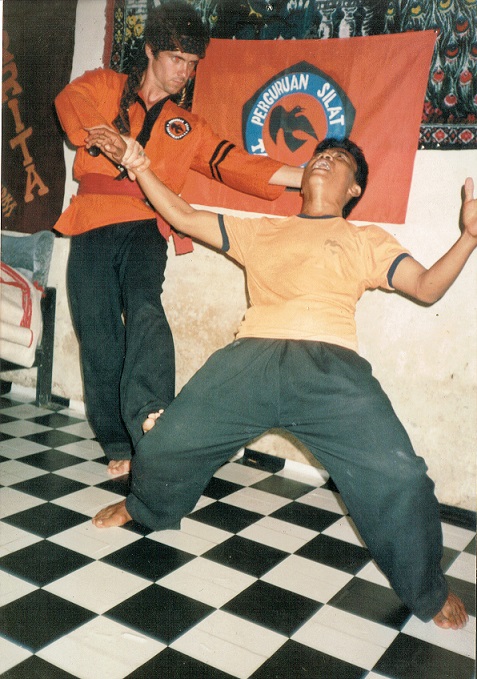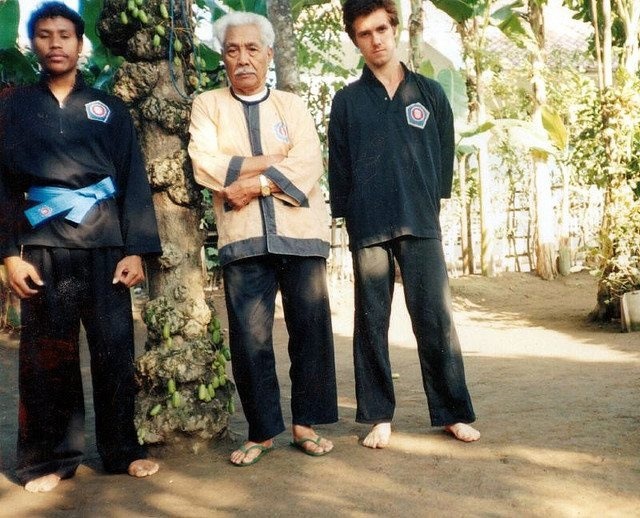Ian Wilson, author of the ‘Politics of Inner Power: The Practice of Pencak Silat in West Java’, describes himself as an ‘accidental academic’. He came to be a researcher out of his desire to learn more about pencak silat and his desire to strengthen his practice as a martial artist. In this interview, he shares his experience as a practitioner and the social, cultural and political embeddedness of pencak silat – a form of martial arts that oscillates between traditional practice and a modernised sport.
How did you get into pencak silat?
When I was in my early twenties I had developed an interest in martial arts. This was quite some time ago now. I had also started to become interested in Indonesia and I was keen to find out what kinds of martial arts were practiced there. It was around this time in the early 1990s that I found Donn F Draeger’s book, The Weapons and Fighting Arts of Indonesia. Although I came to realise that there were numerous errors in Draeger’s book, it was still a part of the impetus for my learning of Indonesian martial arts. Soon after, I found a pencak silat instructor in Perth. His name was David Jennings, who was teaching a kind of combination of Javanese and Balinese styles of pencak silat. David was also the coach of the Australian national team.
After some initial training in Perth with David, I then went to Yogyakarta to find a teacher and a school. This was about 1992-93. I had a social-cultural visa (visa sosial-budaya), and in pre-internet days I had to improvise in order to find a teacher. So, I asked around and there was a becak driver whom I got along with, and he ended up pointing me to Pak Joyo’s school which was known as Bayu Manunggal. This was a traditional silat school and located right in the heart of what has now become a heavily touristed area on Jalan Prawirotaman. It had a beautiful training ground made of compacted earth and a simple annex where the students lived. The surface was tough and the training process both broke me down and re-made me, physically and mentally.
What was it like studying silat in Yogya?
In a relatively short time, I was able to become proficient in the style that Pak Joyo taught. For my suap nasi or daily sustenance, I also taught the junior students at Bayu Manunggal. So, basically, this was a very traditional setting, where as one progressed one taught the younger or less-experienced students. The hierarchy and progress were not so formalised but depended on Pak Joyo’s recognition of a student’s practical and ethical development. Pak Joyo’s school was well infused with Kejawan practices. We would do things like kungkung – which is a practice of meditating while being submerged in water. We would be sent up to Merapi for overnight trips which my colleagues found terrifying as it was a world populated by jin and kuntilanak. The school was also very open in terms of religion. Pak Joyo was a kind of Javanese-Buddhist and had connections with the Buddhists out at Borobudur. Spiritual practices were a strong part of pencak silat; something which has changed significantly over the last few years.
In my early months of being at the school, I spoke Indonesian well enough to communicate. But, I realised pretty quickly that if I didn’t speak Javanese I wouldn’t know what was going on. So, I learned some Javanese – albeit not very well. My knowledge of Javanese was limited to the relevant terms, concepts and practices of silat.

Did you study pencak silat elsewhere?
After my time in Yogyakarta, I left for Bandung as I was keen to learn another style. The diversity of pencak silat is well-known and I wanted to make the most of my time. Again, I had to improvise in order to find a place to study. This time it was on the back of information from mikrolet (mini-bus) drivers who told me to go to a school (perguruan) known as Taji Malela. This is a name of a Sundanese king, and the school was founded by the Kusamadinata family who have a strong Sundanese and pencak silat heritage. This was a rather different setting from my traditional school in Yogya; this school was in down-town Bandung and my Java-centric mannerisms caused some mirth amongst my fellow students (saudara seperguruan). They told me I had to be de-Javanised through changing my etiquette, language and silat style, which they all found a little quaint. As I did in Yogya, I tried to learn some local language, here Sundanese. But, this wasn’t necessary. The school had taken on foreign students prior to me, and in my case, they were well pleased that I spoke Indonesian.
To what degree did you have to have competence in Sundanese to study pencak silat in Bandung? How did Bandung compare to your time in Yogya?
Of course, silat is a bodily practice and thus spoken language is kind of secondary to the main task at hand. So, the inability to speak Sundanese wasn’t so much of a barrier. It is a non-verbal practice. The teachers would often simply instruct me, or the group, to stand up, and then show us the movements. We’d then imitate the movements. Working out what needed to be explained specifically and what just was implied (or shouldn’t be questioned) was a part of the learning process. Some of my teachers said that I talked too much.
My time in Bandung was quite different from what I experienced in Yogyakarta. My pencak silat teacher was also a member of a rather cheesy rock group called Paramor and was also involved in Golkar which of course was very dominant at the time. He was involved in the military. In other words, he wasn’t so traditionally oriented as Pak Joyo back in Yogya. Many members of the pencak silat school were working class men. And thus, silat was not simply a cultural experience, but it also provided them with a life skill and contributed to their employability.
So, how did pencak silat become an academic interest?
My initial foray into pencak silat was an exploration of my personal interests. It was only after being in Yogyakata and Bandung that I started to figure out more clearly what I wanted to do. Pencak silat got me into academia. Doing a PhD was the clearest means through which I could get to travel to different schools of pencak silat and to visit the important teachers.
Can you give us an idea of the variety that exists across pencak silat?
Present day pencak silat exists in a kind of tension or continuum between traditional bodily practice with a codified, modern sport. The sportification of pencak silat was a part of the New Order and the term became a catch-all for all the varieties of silat found throughout Indonesia. These varieties also include ‘main po’, to play at forgetting, and usik which is about irritating. This is very similar to what happened earlier with wushu throughout China – but it is not always easy to bring this comparison up in conversation. I also practiced silat in its competitive form and represented Australia in some international tournaments. However, I found over time that this was not where my passion lay, perhaps partly because of the first places where I learned it – i.e. in a traditional, Kejawen-oriented setting.
We also see how pencak silat relates to particular forms of Islam. Both Muhammadiyah and Nadhlatul Ulama (NU) are aligned with different styles of silat. Tapak Suci is the ‘modern’ form of silat embraced by Muhammadiyah, while for NU it is Pagar Nusa. This kind is more mystically oriented, involving ideas of invulnerability (ilmu kebal) and magic (ilmu kesaktian) and is regarded as being a kind of syirik (blasphemy) by those who follow a modernist interpretation of Islamic practice – such as Muhammadiyah. The values of the Islamic organisations are reflected in the kinds of silat they promote.
How about silat as a sport, does that interest you?
With the strengthening internationalisation of pencak silat as a fighting sport, there have been efforts to make it an Olympic sport. For example, silat is strong in the Netherlands, where they also have their own distinct styles. Although I have competed in a world championship, I am no longer interested in the sporting aspect of silat. I find the codification of silat inimacable to my reasons for doing it – partly because I’m not a flag waving kinda-guy.
Ian Wilson (iwilson@murdoch.edu.au) is a lecturer in Politics and Security Studies, and a research fellow in the Asia Research Centre at Murdoch University.
Related articles from the II archive
Music for the fight
The fighting art of pencak silat
